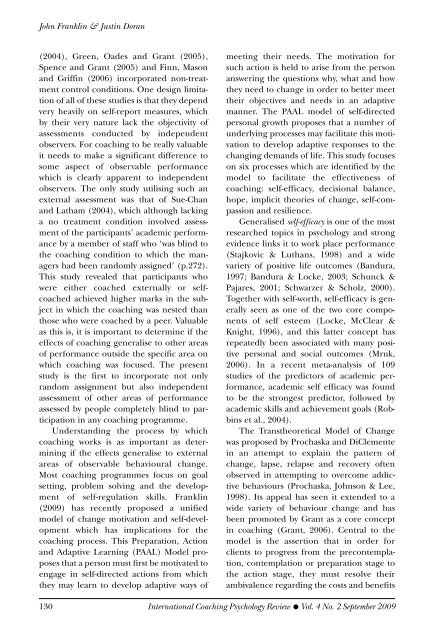International Coaching Psychology Review, 4.2, September 2009
International Coaching Psychology Review, 4.2, September 2009
International Coaching Psychology Review, 4.2, September 2009
You also want an ePaper? Increase the reach of your titles
YUMPU automatically turns print PDFs into web optimized ePapers that Google loves.
John Franklin & Justin Doran<br />
(2004), Green, Oades and Grant (2005),<br />
Spence and Grant (2005) and Finn, Mason<br />
and Griffin (2006) incorporated non-treatment<br />
control conditions. One design limitation<br />
of all of these studies is that they depend<br />
very heavily on self-report measures, which<br />
by their very nature lack the objectivity of<br />
assessments conducted by independent<br />
observers. For coaching to be really valuable<br />
it needs to make a significant difference to<br />
some aspect of observable performance<br />
which is clearly apparent to independent<br />
observers. The only study utilising such an<br />
external assessment was that of Sue-Chan<br />
and Latham (2004), which although lacking<br />
a no treatment condition involved assessment<br />
of the participants’ academic performance<br />
by a member of staff who ‘was blind to<br />
the coaching condition to which the managers<br />
had been randomly assigned’ (p.272).<br />
This study revealed that participants who<br />
were either coached externally or selfcoached<br />
achieved higher marks in the subject<br />
in which the coaching was nested than<br />
those who were coached by a peer. Valuable<br />
as this is, it is important to determine if the<br />
effects of coaching generalise to other areas<br />
of performance outside the specific area on<br />
which coaching was focused. The present<br />
study is the first to incorporate not only<br />
random assignment but also independent<br />
assessment of other areas of performance<br />
assessed by people completely blind to participation<br />
in any coaching programme.<br />
Understanding the process by which<br />
coaching works is as important as determining<br />
if the effects generalise to external<br />
areas of observable behavioural change.<br />
Most coaching programmes focus on goal<br />
setting, problem solving and the development<br />
of self-regulation skills. Franklin<br />
(<strong>2009</strong>) has recently proposed a unified<br />
model of change motivation and self-development<br />
which has implications for the<br />
coaching process. This Preparation, Action<br />
and Adaptive Learning (PAAL) Model proposes<br />
that a person must first be motivated to<br />
engage in self-directed actions from which<br />
they may learn to develop adaptive ways of<br />
meeting their needs. The motivation for<br />
such action is held to arise from the person<br />
answering the questions why, what and how<br />
they need to change in order to better meet<br />
their objectives and needs in an adaptive<br />
manner. The PAAL model of self-directed<br />
personal growth proposes that a number of<br />
underlying processes may facilitate this motivation<br />
to develop adaptive responses to the<br />
changing demands of life. This study focuses<br />
on six processes which are identified by the<br />
model to facilitate the effectiveness of<br />
coaching: self-efficacy, decisional balance,<br />
hope, implicit theories of change, self-compassion<br />
and resilience.<br />
Generalised self-efficacy is one of the most<br />
researched topics in psychology and strong<br />
evidence links it to work place performance<br />
(Stajkovic & Luthans, 1998) and a wide<br />
variety of positive life outcomes (Bandura,<br />
1997; Bandura & Locke, 2003; Schunck &<br />
Pajares, 2001; Schwarzer & Scholz, 2000).<br />
Together with self-worth, self-efficacy is generally<br />
seen as one of the two core components<br />
of self esteem (Locke, McClear &<br />
Knight, 1996), and this latter concept has<br />
repeatedly been associated with many positive<br />
personal and social outcomes (Mruk,<br />
2006). In a recent meta-analysis of 109<br />
studies of the predictors of academic performance,<br />
academic self efficacy was found<br />
to be the strongest predictor, followed by<br />
academic skills and achievement goals (Robbins<br />
et al., 2004).<br />
The Transtheoretical Model of Change<br />
was proposed by Prochaska and DiClemente<br />
in an attempt to explain the pattern of<br />
change, lapse, relapse and recovery often<br />
observed in attempting to overcome addictive<br />
behaviours (Prochaska, Johnson & Lee,<br />
1998). Its appeal has seen it extended to a<br />
wide variety of behaviour change and has<br />
been promoted by Grant as a core concept<br />
in coaching (Grant, 2006). Central to the<br />
model is the assertion that in order for<br />
clients to progress from the precontemplation,<br />
contemplation or preparation stage to<br />
the action stage, they must resolve their<br />
ambivalence regarding the costs and benefits<br />
130 <strong>International</strong> <strong>Coaching</strong> <strong>Psychology</strong> <strong>Review</strong> ● Vol. 4 No. 2 <strong>September</strong> <strong>2009</strong>

















